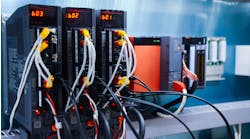Our multipurpose industrial site in Onesti, Romania, offers many applications for flow instrumentation. The CAROM facility produces butadiene, methyl tert-butyl ether (MTBE) gasoline additive, liquefied petroleum gas and synthetic rubber. It also includes a fully equipped terminal for the storage and distribution of road bitumen and has a transportation infrastructure for petroleum and petrochemical-based products.
As energy chief engineer for CAROM Onesti, I continually am looking for ways to reduce costs and increase efficiencies by using instrumentation to optimize processes at the plant. For example, we replaced inaccurate and unreliable flow instrumentation with the latest Coriolis and vortex technologies. The accurate and reliable measurements from these flow meters have enabled improvements that together have provided savings of €1 million/y ($1.09 million/y).
Figure 1. This flow meter has enabled a better mass balance, leading to significant improvement in plant efficiency.
Better Mass Balance
The production of MTBE and synthetic rubber relies on distillation columns to split raw C4 into its different types of isomers. Each column must be balanced to achieve the maximum production target, with an optimal ratio of C4 and extractives input. The etherification process involved in the production of MTBE also requires precise dosing and control of methanol and C4. Process temperature is never constant because part of the feedstock material comes from production and part from storage where it is conditioned by the weather. As a result, the concentration is not always the same.
[javascriptSnippet ]
A good mass balance is vital for such complex plant processes; achieving that balance requires accurate and reliable flow measurement. However, the differential pressure (DP) flow meters that we were using demanded frequent maintenance because process fluids sometimes polymerized inside the meters, clogging impulse lines, which led to bad measurements.
Starting in 2008 and wrapping up in 2010, we replaced the unreliable DP meters with Micro Motion Coriolis flow meters from Emerson Process Management (Figure 1). These devices provide accurate and reliable measurements of mass flow, unaffected by changes in pressure and temperature. In addition, the meters have no moving parts to wear or fail, which allowed us to significantly reduce maintenance requirements.
The meters have improved mass balance in unit operations for the production of MTBE and butadiene, where they handle flow and concentration measurement. By achieving the required mass balance, we avoided 150 mt of product loss every month — with a value of €700,000/y ($760,000/y). Based on current production figures, this saving translates into a 2% increase in overall plant efficiency.
Higher Steam System Efficiency
Meanwhile, at a different location within the site, production units rely on nine thermal plants to deliver superheated steam at a constant pressure to maintain product quality and composition. However, the three orifice flow meters used to measure the flow of superheated steam were suffering a number of leakage problems in their impulse lines. On average, the three meters required a total of around 300 h/y of maintenance.
Although the process could continue running during meter maintenance, we lost valuable measurement data for that period. The resulting poor control wasted up to 2 mt/h of steam, increasing the amount of fuel needed to meet the demand. We also were concerned that the steam leaks presented a safety risk to workers. The lack of precise measurements not only reduced operational efficiency but also limited our ability to apply optimization technologies on the steam network.
Figure 2. The meter decreased steam leaks dramatically, increasing steam system efficiency and providing very fast payback.
To solve these problems, we needed to replace the unreliable orifice-plate flow meters with the best technology available for superheated steam measurement. We chose Rosemount 8800D vortex flow meters from Emerson (Figure 2). These meters have an all-cast body to eliminate leaks and minimize maintenance requirements. In addition, their multivariable vortex design incorporates temperature sensors that use the meter’s shedder bar as a thermowell. This keeps the vortex and temperature sensors isolated from the process for easy verification and replacement without stopping operations. The meters’ electronics compensate for changes in the process temperature, improving performance with saturated steam.
After we installed the vortex meters in 2012, we saw immediate improvements. Maintenance requirements fell to almost nothing and, because steam loss was drastically reduced, the steam system efficiency rose by 3% — saving more than €200,000/y ($218,000/y) in fuel. We recovered our initial investment in just 25 days of operation.
Each of our flow meter applications presents different challenges; it’s important to choose the best technology to provide accurate and reliable results with minimal maintenance. We have successfully addressed our measurement problems by combining our local team’s process knowledge with Emerson’s product and application expertise.
MARIAN STANCU is energy chief engineer for CAROM Onesti, Onesti, Romania. E-mail him at [email protected].

